Geoscience Reference
In-Depth Information
that over 80 per cent of pollutant particles are
washed into a drainage system within the first 6-10
mm of rain falling (D'Arcy
et al
., 1998), and often
from a very small collection area within the urban
catchment (Lee and Bang, 2000). This information
is important when proposing strategies to deal
with the urban pollutant runoff. One of the main
methods is to create an artificial wetland within an
urban setting so that the initial flush of storm
runoff is collected, slowed down, and pollutants
can be modified by biological action. Shutes (2001)
has a review of artificial wetlands in Hong Kong,
Malaysia and England and discussed the role of
plants in improving water quality. Scholes
et al
.
(1999) showed that two artificial wetlands in
London, England were efficient in removing heavy
metals and lowering the BOD of urban runoff
during storm events. Carapeto and Purchase (2000)
reported similar efficiency for the removal of
cadmium and lead from urban runoff.
600
0.8
Permeable area
BFI
0.6
400
0.4
200
0.2
0
0
1980
1985
1990
1995
2000
2005
Figure 8.12
Baseflow index (BFI - proportion of annual
streamflow as baseflow) with time in a small catchment
in Auckland, New Zealand where there has been steady
urbanisation. The vertical bars show area of permeable
surfaces estimated from aerial photographs at 4 times.
Source
: Data courtesy of Auckland Regional Council
caused by an increase in the stormflow and total flow
and the actual amount of baseflow has stayed the
same. Whichever way, there has been a change in
the hydrological regime that can probably be
attributed to the rise in permeable surfaces as a
result of urbanisation.
River channelisation
It is a common practice to channelise rivers as
they pass through urban areas in an attempt to
lessen floods in the urban environment. Frequently,
although not always, this will involve straighten-
ing a river reach and this has impacts on the
streamflow. Simons and Senturk (1977) list some of
the hydrological impacts of channel straightening:
higher velocities in the channel; increased sediment
transport and possible base degradation; increased
stormflow stage (height); and deposition of material
downstream of the straightening. The impact of
urban channelisation is not restricted to the chan-
nelised zone itself. The rapid movement of water
through a channelised reach will increase the
velocity, and may increase the magnitude, of a flood
wave travelling downstream. Deposition of sedi-
ment downstream from the channelised section may
leave the area prone to flooding through a raised
river bed.
Pollution from urban runoff
There is a huge amount of research and literature
on the impacts of urbanisation on urban water
quality. Davis
et al
. (2001) link the accumulation of
heavy metals in river sediments to urban runoff,
particularly from roads. Specific sources are tyre
wear and vehicle brakes for zinc, and buildings for
lead, copper, cadmium and zinc (Davis
et al
., 2001).
In Paris, Gromaire-Mertz
et al
. (1999) found high
concentrations of heavy metals in runoff from roofs,
while street runoff had a high suspended solids and
hydrocarbon load. The hydrocarbons are of particu-
lar concern, especially the carcinogenic polycyclic
aromatic hydrocarbons (PAH) derived from petrol
engines. Krein and Schorer (2000) trace PAHs from
road runoff into river sediments where they bind
onto fine sand and silt particles.
The nature of urban runoff (low infiltration and
rapid movement of water) concentrates the pollu-
tants in the first flush of water. Studies have shown



